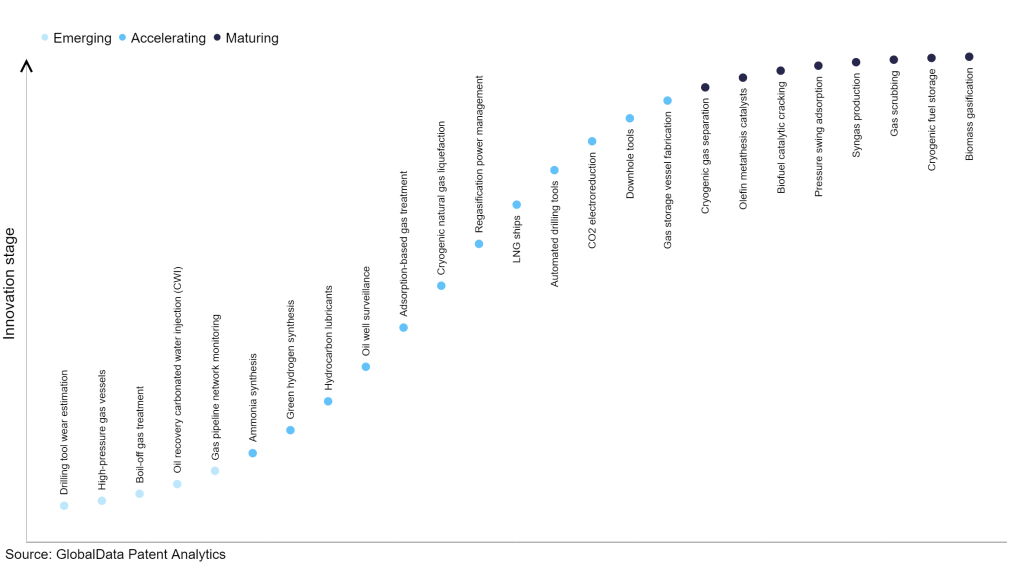The oil and gas industry continues to be a hotbed of patent innovation. Activity is driven by the need for improved productivity, safety and sustainability, with growing interest in technologies such as green hydrogen, fuel cells, and carbon capture and storage (CCS). In the last three years alone, there have been over 523,000 patents filed and granted in the oil and gas industry, according to GlobalData’s report on Innovation in oil & gas: hydrocarbon lubricants. Buy the report here.
However, not all innovations are equal and nor do they follow a constant upward trend. Instead, their evolution takes the form of an S-shaped curve that reflects their typical lifecycle from early emergence to accelerating adoption, before finally stabilizing and reaching maturity.
Identifying where a particular innovation is on this journey, especially those that are in the emerging and accelerating stages, is essential for understanding their current level of adoption and the likely future trajectory and impact they will have.
60+ innovations will shape the oil & gas industry
According to GlobalData’s Technology Foresights, which plots the S-curve for the oil & gas industry using innovation intensity models built on over 196,000 patents, there are 60+ innovation areas that will shape the future of the industry.
Within the emerging innovation stage, high-pressure gas vessels, boil-off gas treatment, and oil recovery CWI are disruptive technologies that are in the early stages of application and should be tracked closely. Green hydrogen synthesis, hydrocarbon lubricants, and oil well surveillance are some of the accelerating innovation areas, where adoption has been steadily increasing. Among maturing innovation areas are cryogenic gas separation and olefin metathesis catalysts, which are now well established in the industry.
Innovation S-curve for the oil & gas industry

Hydrocarbon-based lubricants is a key innovation area in oil & gas
Hydrocarbon-based lubricants are generally made up of paraffinic and naphthenic compounds. These are essentially heavier compounds obtained during crude oil refining. Petrochemical companies add additives to these compounds to impart specific properties, transforming them into lubricants and other useful products. Depending upon the end-application, the properties of hydrocarbon-based lubricants, such as viscosity, can be attained.
GlobalData’s analysis also uncovers the companies at the forefront of each innovation area and assesses the potential reach and impact of their patenting activity across different applications and geographies. According to GlobalData, there are 60+ companies, spanning technology vendors, established oil & gas companies, and up-and-coming start-ups engaged in the development and application of hydrocarbon-based lubricants.
Key players in hydrocarbon-based lubricants – a disruptive innovation in the oil & gas industry
‘Application diversity’ measures the number of applications identified for each patent. It broadly splits companies into either ‘niche’ or ‘diversified’ innovators.
‘Geographic reach’ refers to the number of countries each patent is registered in. It reflects the breadth of geographic application intended, ranging from ‘global’ to ‘local’.
Patent volumes related to hydrocarbon-based lubricants
Source: GlobalData Patent Analytics
The leaders in hydrocarbon-based lubricants patent fillings include Chemours, Idemitsu, Honeywell, ExxonMobil, and DuPont. Lubricants are used to reduce wear and tear in rotating machinery, while ensuring smoother operations. Therefore, lubricants are consumed in a variety of industry verticals where heavy machinery is found. The use of lubricants is also found in end-consumer sectors for tasks such as vehicle maintenance.
Honeywell offers lubricants for industrial consumption, which include polyethylene waxes and other high-performance products.
ExxonMobil’s lubricant offerings include marine lubricants, such as engine oils and lubricants for auxiliary machinery. Its lubricants offerings in the automobile sector include engine oils and gear oils. It also offers other industrial lubricants for equipment used in energy, petrochemical, and manufacturing sectors.
DuPont offers lubricants for compressors, pumps and other multipurpose oils for industrial applications. It also offers refrigeration lubricants for safe and efficient operation of mobile air conditioning systems. Additionally, it offers lubricants and fluids for automotive applications.
To further understand the key themes and technologies disrupting the oil & gas industry, access GlobalData’s latest thematic research report on Oil & Gas.
Data Insights
From

The gold standard of business intelligence.
Blending expert knowledge with cutting-edge technology, GlobalData’s unrivalled proprietary data will enable you to decode what’s happening in your market. You can make better informed decisions and gain a future-proof advantage over your competitors.



